
Anthozoa is a class of marine invertebrates which includes the sea anemones, stony corals and soft corals. Adult anthozoans are almost all attached to the seabed, while their larvae can disperse as part of the plankton. The basic unit of the adult is the polyp; this consists of a cylindrical column topped by a disc with a central mouth surrounded by tentacles. Sea anemones are mostly solitary, but the majority of corals are colonial, being formed by the budding of new polyps from an original, founding individual. Colonies are strengthened by calcium carbonate and other materials and take various massive, plate-like, bushy or leafy forms.
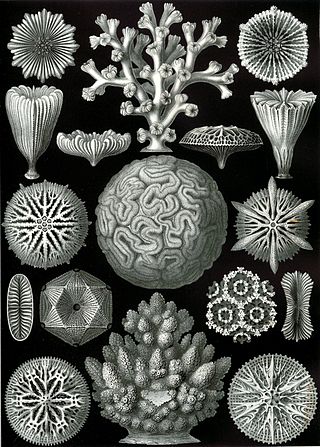
Scleractinia, also called stony corals or hard corals, are marine animals in the phylum Cnidaria that build themselves a hard skeleton. The individual animals are known as polyps and have a cylindrical body crowned by an oral disc in which a mouth is fringed with tentacles. Although some species are solitary, most are colonial. The founding polyp settles and starts to secrete calcium carbonate to protect its soft body. Solitary corals can be as much as 25 cm (10 in) across but in colonial species the polyps are usually only a few millimetres in diameter. These polyps reproduce asexually by budding, but remain attached to each other, forming a multi-polyp colony of clones with a common skeleton, which may be up to several metres in diameter or height according to species.
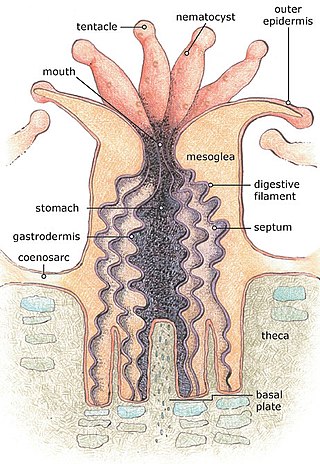
A corallite is the skeletal cup, formed by an individual stony coral polyp, in which the polyp sits and into which it can retract. The cup is composed of aragonite, a crystalline form of calcium carbonate, and is secreted by the polyp. Corallites vary in size, but in most colonial corals they are less than 3 mm (0.12 in) in diameter. The inner surface of the corallite is known as the calyx. The vertical blades inside the calyx are known as septa and in some species, these ridges continue outside the corallite wall as costae. Where there is no corallite wall, the blades are known as septocostae. The septa, costae and septocostae may have ornamentation in the form of teeth and may be thick, thin or variable in size. Sometimes there are paliform lobes, in the form of rods or blades, rising from the inner margins of the septa. These may form a neat circle called the paliform crown. The septa do not usually unite in the centre of the corallite, instead they form a columella, a tangled mass of intertwined septa, or a dome-shaped or pillar-like projection. In the living coral, the lower part of the polyp is in intimate contact with the corallite, and has radial mesenteries between the septa which increase the surface area of the body cavity and aid digestion. The septa, palliform lobes and costae can often be seen through the coenosarc, the layer of living tissue that covers the coenosteum, the part of the skeleton between the corallites.

Fire corals (Millepora) are a genus of colonial marine organisms that exhibit physical characteristics similar to that of coral. The name coral is somewhat misleading, as fire corals are not true corals but are instead more closely related to Hydra and other hydrozoans, making them hydrocorals. They make up the only genus in the monotypic family Milleporidae.
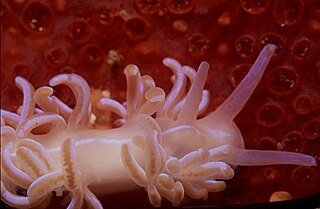
Phyllodesmium horridum, the coral nudibranch, is a species of sea slug, specifically an aeolid nudibranch. It is a marine gastropod mollusc in the family Facelinidae.

Corynactis annulata, or the strawberry anemone, is a bright pink colonial anthozoan similar in body form to sea anemones and scleractinian stony corals. This species is a solitary animal of the order Corallimorpharia.

The multicoloured sea fan is a species of gorgonian sea fan in the family Melithaeidae.
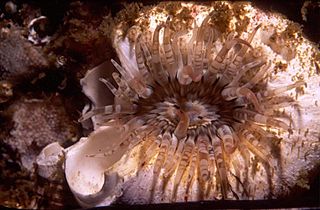
The ring-tentacle anemone is a species of sea anemone in the family Isanthidae.

Balanophyllia is a genus of solitary corals in the order of stony corals.

The purple soft coral is a species of colonial soft coral in the family Alcyoniidae.
The Valdivian soft coral is a species of colonial leathery or soft coral in the family Alcyoniidae.

The variable soft coral is a species of colonial soft coral in the family Alcyoniidae.

Cynarina lacrymalis is a species of stony coral in the family Lobophylliidae. It is variously known as the flat cup coral, solitary cup coral, button coral, doughnut coral, or cat's eye coral. It is found in the western Indo-Pacific Ocean and is sometimes kept in reef aquaria.

The cauliflower soft coral is a species of colonial soft coral in the family Nephtheidae.
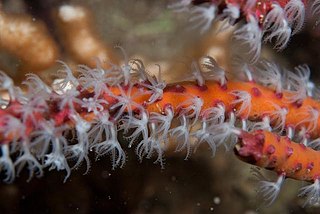
The gorgonian twig coral is a species of gorgonian sea fan in the family Anthothelidae.

Stylaster nobilis, the noble coral, is a branching colonial hydroid in the family Stylasteridae.

Leptopsammia pruvoti, the sunset cup coral, is a solitary stony coral in the family Dendrophylliidae. It is an azooxanthellate species, meaning its tissues do not contain the symbiotic unicellular algae (zooxanthellae) of the genus Symbiodinium, as do most corals. It is native to the Mediterranean Sea. The species was described by Henri de Lacaze-Duthiers in 1897 and named to honor the French marine biologist Georges Pruvot.
Cup coral may refer to several different taxa of coral including:

Balanophyllia elegans, the orange coral or orange cup coral, is a species of solitary cup coral, a stony coral in the family Dendrophylliidae. It is native to the eastern Pacific Ocean. As an azooxanthellate species, it does not contain symbiotic dinoflagellates in its tissues in the way that most corals do.

The Marine biodiversity of South Africa is the variety of living organisms that live in the seas off the coast of South Africa. It includes genetic, species and ecosystems biodiversity in a range of habitats spread over a range of ecologically varied regions, influenced by the geomorphology of the seabed and circulation of major and local water masses, which distribute both living organisms and nutrients in complex and time-variable patterns.



















